The dumbbell curl is the cornerstone of most weightlifters’ biceps training.
It’s widely used because it’s simple, effective, and adaptable for most anyone’s circumstances, which makes it ideal for maximizing your biceps development.
In this article, you’ll learn what a dumbbell curl is, why it’s beneficial, which muscles it works, how to do a proper dumbbell curl, the best dumbbell curl variations, and more.
What Is the Dumbbell Curl?
The dumbbell curl—also referred to as the “dumbbell biceps curl” or “biceps curl”—is a biceps isolation exercise that involves lifting a dumbbell from your waist to your shoulder by bending at the elbow, then straightening your arm.
There are many biceps curl variations, but perhaps the most common—and the one we’ll focus on in this article—is the standing alternating dumbbell curl (sometimes referred to as the “standing dumbbell supinated curl”).
As the name implies, you perform this variation while standing and train each arm separately, alternating between your arms with every rep.
Barbell Curl vs. Dumbbell Curl: Which Is Better?
The barbell and dumbbell curl are similar biceps exercises. What makes them different is that in the dumbbell biceps curl you use dumbbells, and in the barbell curl you use a barbell.
This means the dumbbell curl trains your biceps unilaterally (one arm at a time), while the barbell biceps curl trains your biceps bilaterally (both arms simultaneously).
It also means that during the barbell curl, your hands are fixed in a supinated (palms up) position during every rep, whereas in the dumbbell curl, your wrists can move more freely.
This is significant because keeping the wrists supinated can aggravate your wrists and elbows. As such, some people find the dumbbell curl more comfortable than the barbell curl because they can turn their wrists inward slightly to avoid pain.
That said, if you can perform both exercises without discomfort, neither is better or worse than the other—they train the same muscles to a similar degree, so you can use them interchangeably.
A good way to do this is to include the dumbbell curl in your program for 8-to-10 weeks of training, take a deload, then replace the dumbbell curl with the barbell curl for the following 8-to-10 weeks of training.
Then, you can either continue alternating between the exercises every few months like this or stick with the one you prefer.
This is how I personally like to organize my training, and it’s similar to the method I advocate in my fitness books for men and women, Bigger Leaner Stronger and Thinner Leaner Stronger.
(And if you’d like even more specific advice about how you should organize your training to reach your health and fitness goals, take the Legion Strength Training Quiz, and in less than a minute, you’ll know the perfect strength training program for you. Click here to check it out.)
Dumbbell Curl: Benefits
1. It maximizes biceps growth.
Your biceps are heavily involved in “pulling” exercises, such as the lat pulldown, row, and pull-up.
However, research shows that if you want to maximize biceps development, doing compound pulling exercises isn’t enough—you have to do biceps isolation exercises, too.
There are two reasons for this.
First, biceps isolation exercises like the dumbbell biceps curl allow you to train your biceps in different ways—at different angles and through different ranges of motion—which probably produces more balanced and complete growth than doing just 2 or 3 pulling exercises.
And second, biceps isolation exercises allow you to train your biceps when it’s no longer practical to do so with a compound exercise.
For instance, your lats, traps, and rhomboids will probably be bushed after several sets of pulling exercises, but your biceps may be comparatively fresh. Training them with a few sets of curls ensures they’re adequately stimulated, which is vital to maximize growth.
2. It trains your biceps unilaterally.
The alternating dumbbell curl is a unilateral exercise, which means it allows you to train one side of your body at a time.
This is beneficial because unilateral exercises . . .
- May enable you to lift more total weight than you can with some bilateral exercises, which may help you gain more muscle over time
- Help you develop a greater mind-muscle connection with your biceps because you only need to focus on one side of your body at a time
- Help you correct muscle imbalances, because both sides of your body are forced to lift the same amount of weight (one side can’t “take over” from the other)
3. It’s highly adaptable.
There are several dumbbell curl variations that place your arms in varying positions relative to your torso.
For example, the regular biceps curl places your arms by your sides, the dumbbell preacher curl places your arms in front of your torso, and the incline dumbbell biceps curl places your arms behind your torso.
This is important because research shows that training your biceps with your arms in different positions is one of the best ways to build proportional biceps.
Dumbbell Curl: Muscles Worked
The main muscle worked by the biceps curl is the biceps brachii (often shortened to the “biceps”), the two-headed muscle located on the front of the upper arm, between the shoulder and elbow.
To a lesser extent, it also trains the brachialis, a small muscle that lies beneath the biceps that significantly adds to the biceps’ size and circumference, and several forearm muscles, including the brachioradialis and pronator teres.
Here’s how the biceps look on your body:
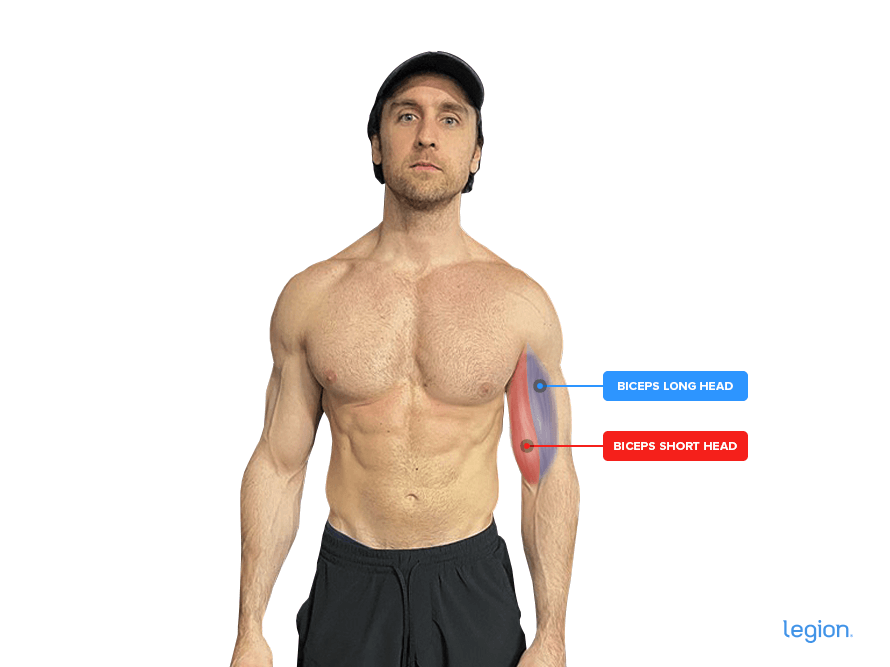
How to Do the Dumbbell Curl
The easiest way to learn how to do a dumbbell curl is to split the exercise into three parts: set up, curl, and descend.
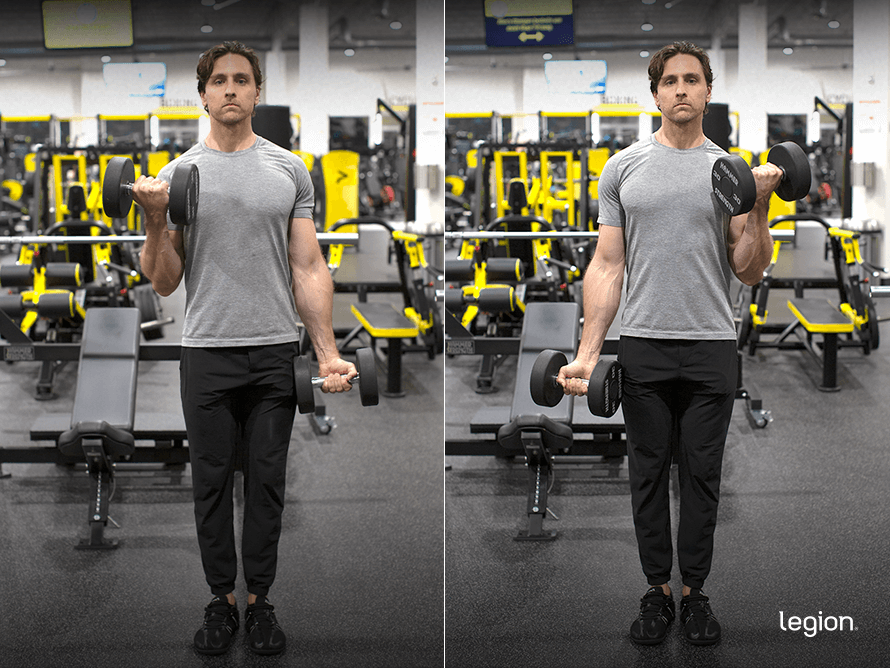
Step 1: Set Up
Hold a dumbbell in each hand with your palms facing away from you and your arms hanging at your sides. Stand up straight with your feet shoulder-width apart.
Step 2: Curl
Without twisting your wrist, curl your right hand toward your right shoulder until your forearm is roughly perpendicular to the floor. Allow your elbow to move forward slightly as the dumbbell rises.
Step 3: Descend
Lower the dumbbell and return to the starting position. Don’t let the weight fall back to the starting position or try to straighten your arm slowly. The entire “descent” should be controlled but only take about a second.
Once your right hand is back at your side, repeat the pattern with your left hand (to complete one full rep).
Here’s how it should look when you put it all together:
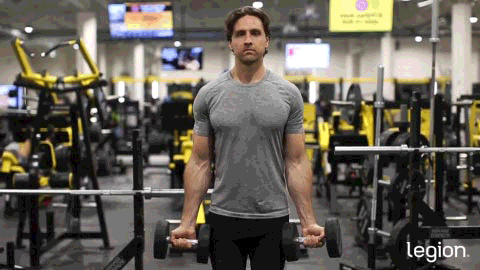
The Best Dumbbell Curl Variations
1. Single-Arm Dumbbell Curl
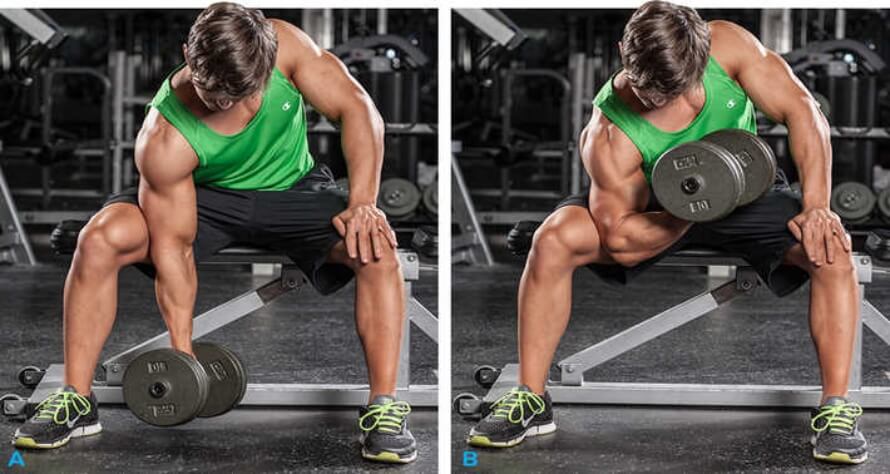
Research shows that the single-arm dumbbell curl (often referred to as the “dumbbell concentration curl” or “single dumbbell curl”) is an excellent exercise for training your biceps.
What makes it so effective is that it places your elbow against the inside of your thigh or knee, preventing you from using momentum to “cheat” the weight up and forcing your biceps to do the lion’s share of the work.
2. Dumbbell Preacher Curl
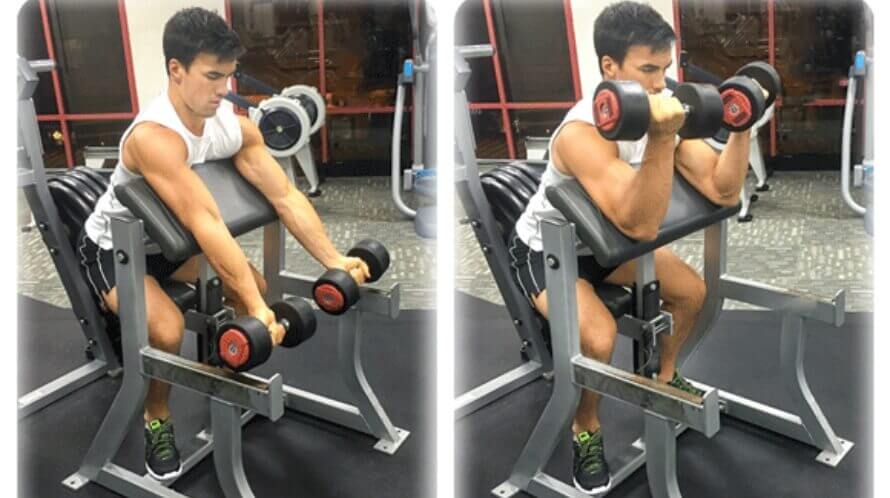
In the dumbbell preacher curl, you place your upper arms against a preacher curl bench. Similarly to the single-arm dumbbell curl, this prevents you from using momentum to lift the weight. This ensures your biceps do the majority of the work, which should help you gain more biceps size and strength over time.
3. Incline Dumbbell Biceps Curl
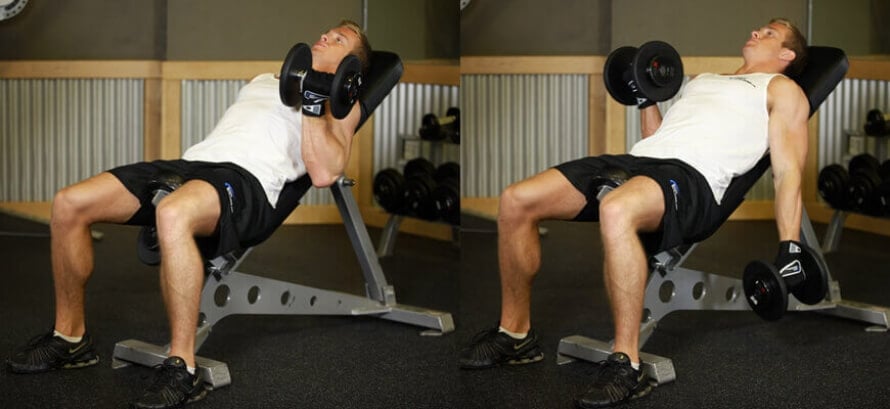
Unlike many other biceps exercises, the incline dumbbell biceps curl places constant tension on your biceps throughout the entire range of motion and trains your biceps in a fully stretched position, which is generally better for muscle growth.
Scientific References +
- De Vasconcelos Costa, B. D., Kassiano, W., Nunes, J. P., Kunevaliki, G., Castro-E-Souza, P., Rodacki, A., Cyrino, L. T., Cyrino, E. S., & Fortes, L. D. S. (2021). Does Performing Different Resistance Exercises for the Same Muscle Group Induce Non-homogeneous Hypertrophy? International Journal of Sports Medicine, 42(9), 803–811. https://doi.org/10.1055/A-1308-3674
- Schoenfeld, B. J. (2010). The mechanisms of muscle hypertrophy and their application to resistance training. Journal of Strength and Conditioning Research, 24(10), 2857–2872. https://doi.org/10.1519/JSC.0B013E3181E840F3
- Jakobi, J. M., & Chilibeck, P. D. (2001). Bilateral and unilateral contractions: possible differences in maximal voluntary force. Canadian Journal of Applied Physiology = Revue Canadienne de Physiologie Appliquee, 26(1), 12–33. https://doi.org/10.1139/H01-002
- Janzen, C. L., Chilibeck, P. D., & Davison, K. S. (2006). The effect of unilateral and bilateral strength training on the bilateral deficit and lean tissue mass in post-menopausal women. European Journal of Applied Physiology, 97(3), 253–260. https://doi.org/10.1007/S00421-006-0165-1/METRICS
- Barakat, C., Barroso, R., Alvarez, M., Rauch, J., Miller, N., Bou-Sliman, A., & De Souza, E. O. (2019). The Effects of Varying Glenohumeral Joint Angle on Acute Volume Load, Muscle Activation, Swelling, and Echo-Intensity on the Biceps Brachii in Resistance-Trained Individuals. Sports 2019, Vol. 7, Page 204, 7(9), 204. https://doi.org/10.3390/SPORTS7090204
- Oliveira, L. F., Matta, T. T., Alves, D. S., Garcia, M. A. C., & Vieira, T. M. M. (2009). Effect of the shoulder position on the biceps brachii emg in different dumbbell curls. Journal of Sports Science & Medicine, 8(1), 24. /pmc/articles/PMC3737788/
- Kostek, M. T., & Knortz, K. (n.d.). Kinesiology Corner: The Bicep Curl and the Reverse Bicep Cur... : Strength & Conditioning Journal. Retrieved January 23, 2023, from https://journals.lww.com/nsca-scj/Citation/1980/12000/Kinesiology_Corner__The_Bicep_Curl_and_the_Reverse.10.aspx
- Young, S., Porcari, J. P., Camic, C., Kovacs, A., & Foster, C. (2014). ACE STUDY REVEALS BEST BICEPS EXERCISES EXCLUSIVE ACE-SPONSORED RESEARCH. https://acewebcontent.azureedge.net/certifiednews/images/article/pdfs/ACE BicepsStudy.pdf
- Oliveira, L. F., Matta, T. T., Alves, D. S., Garcia, M. A. C., & Vieira, T. M. M. (2009). Effect of the shoulder position on the biceps brachii emg in different dumbbell curls. Journal of Sports Science & Medicine, 8(1), 24. /pmc/articles/PMC3737788/
- Oranchuk, D. J., Storey, A. G., Nelson, A. R., & Cronin, J. B. (2019). Isometric training and long-term adaptations: Effects of muscle length, intensity, and intent: A systematic review. Scandinavian Journal of Medicine & Science in Sports, 29(4), 484–503. https://doi.org/10.1111/SMS.13375










